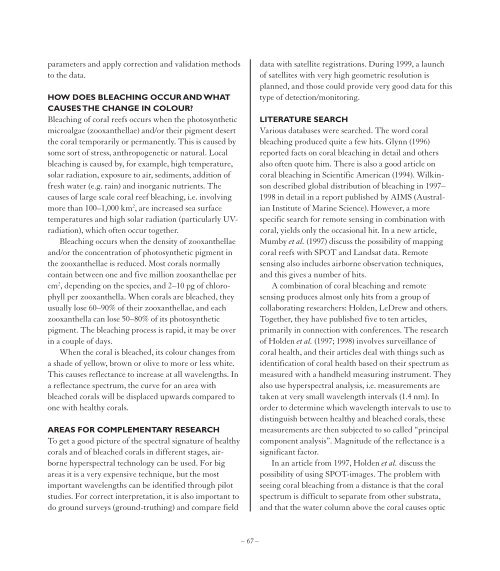Create successful ePaper yourself
Turn your PDF publications into a flip-book with our unique Google optimized e-Paper software.
parameters and apply correction and validation methods<br />
to the data.<br />
HOW DOES BLEACHING OCCUR AND WHAT<br />
CAUSES THE CHANGE IN COLOUR<br />
Bleaching of coral reefs occurs when the photosynthetic<br />
microalgae (zooxanthellae) and/or their pigment desert<br />
the coral temporarily or permanently. This is caused by<br />
some sort of stress, anthropogenetic or natural. Local<br />
bleaching is caused by, for example, high temperature,<br />
solar radiation, exposure to air, sediments, addition of<br />
fresh water (e.g. rain) and inorganic nutrients. The<br />
causes of large scale coral reef bleaching, i.e. involving<br />
more than 100–1,000 km 2 , are increased sea surface<br />
temperatures and high solar radiation (particularly UVradiation),<br />
which often occur together.<br />
Bleaching occurs when the density of zooxanthellae<br />
and/or the concentration of photosynthetic pigment in<br />
the zooxanthellae is reduced. Most corals normally<br />
contain between one and five million zooxanthellae per<br />
cm 2 , depending on the species, and 2–10 pg of chlorophyll<br />
per zooxanthella. When corals are bleached, they<br />
usually lose 60–90% of their zooxanthellae, and each<br />
zooxanthella can lose 50–80% of its photosynthetic<br />
pigment. The bleaching process is rapid, it may be over<br />
in a couple of days.<br />
When the coral is bleached, its colour changes from<br />
a shade of yellow, brown or olive to more or less white.<br />
This causes reflectance to increase at all wavelengths. In<br />
a reflectance spectrum, the curve for an area with<br />
bleached corals will be displaced upwards compared to<br />
one with healthy corals.<br />
AREAS FOR COMPLEMENTARY RESEARCH<br />
To get a good picture of the spectral signature of healthy<br />
corals and of bleached corals in different stages, airborne<br />
hyperspectral technology can be used. For big<br />
areas it is a very expensive technique, but the most<br />
important wavelengths can be identified through pilot<br />
studies. For correct interpretation, it is also important to<br />
do ground surveys (ground-truthing) and compare field<br />
data with satellite registrations. During 1999, a launch<br />
of satellites with very high geometric resolution is<br />
planned, and those could provide very good data for this<br />
type of detection/monitoring.<br />
LITERATURE SEARCH<br />
Various databases were searched. The word coral<br />
bleaching produced quite a few hits. Glynn (1996)<br />
reported facts on coral bleaching in detail and others<br />
also often quote him. There is also a good article on<br />
coral bleaching in Scientific American (1994). Wilkinson<br />
described global distribution of bleaching in 1997–<br />
1998 in detail in a report published by AIMS (Australian<br />
Institute of Marine Science). However, a more<br />
specific search for remote sensing in combination with<br />
coral, yields only the occasional hit. In a new article,<br />
Mumby et al. (1997) discuss the possibility of mapping<br />
coral reefs with SPOT and Landsat data. Remote<br />
sensing also includes airborne observation techniques,<br />
and this gives a number of hits.<br />
A combination of coral bleaching and remote<br />
sensing produces almost only hits from a group of<br />
collaborating researchers: Holden, LeDrew and others.<br />
Together, they have published five to ten articles,<br />
primarily in connection with conferences. The research<br />
of Holden et al. (1997; 1998) involves surveillance of<br />
coral health, and their articles deal with things such as<br />
identification of coral health based on their spectrum as<br />
measured with a handheld measuring instrument. They<br />
also use hyperspectral analysis, i.e. measurements are<br />
taken at very small wavelength intervals (1.4 nm). In<br />
order to determine which wavelength intervals to use to<br />
distinguish between healthy and bleached corals, these<br />
measurements are then subjected to so called “principal<br />
component analysis”. Magnitude of the reflectance is a<br />
significant factor.<br />
In an article from 1997, Holden et al. discuss the<br />
possibility of using SPOT-images. The problem with<br />
seeing coral bleaching from a distance is that the coral<br />
spectrum is difficult to separate from other substrata,<br />
and that the water column above the coral causes optic<br />
– 67 –


















